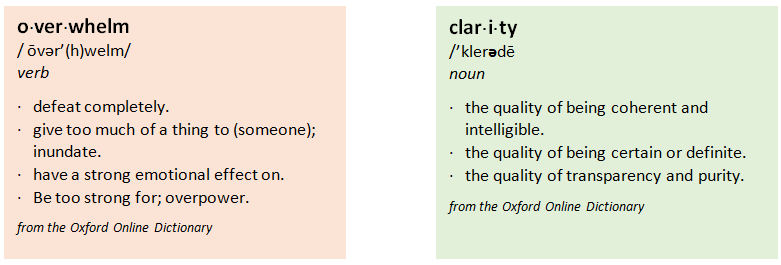 A Coaching Power Tool Created by Caroline Drake
A Coaching Power Tool Created by Caroline Drake
(Leadership Coach, UNITED STATES)
Introduction
Our society places an emphasis on being busy. Somehow busy-ness has become an indicator of importance or productivity but it simply is not. At times, we will be busy, however, busy-ness should not be the norm nor should it diminish our quality of life. Too often busy-ness leads to rushing around and a state of overwhelm.
Today, there are so many competing priorities and activities! Not only must we meet our basic needs but we often have work, family, social media, social events and more competing for our attention and time. Many of my clients come to me stating they are overwhelmed and are juggling too many things. They did so because they felt the pressure to perform, to say yes, to appear productive… Over time this diminished their confidence, limited their ability to effectively prioritize and take action on those priorities, and cultivated a sense that they were out of control – simply reacting and not able to take a moment to step back and control where they desired to go.
My power tool focuses on the state of overwhelm and shifting to a state of clarity. It considers pacing, boundaries and awareness all as means to ensure clients shift to clarity and, more importantly, are equipped to stay in clarity and not slide back into overwhelm.
Explanation

Overwhelm is a state of being that is characterized by feelings of defeat, discouragement and often confusion around priorities. Overwhelm happens when a client is being inundated with too many competing tasks and/or projects and rushing to complete them all. It is not uncommon to hear a client always feels busy but rarely feels productive. Clients report feeling unable to effectively address the demands of work or life, feeling defeated and completely disempowered.
Conversely, clarity is a state of being that is characterized by calm, confidence, possessing a sense of direction. Clients report feeling empowered, confident and capable of completing their goals. Clarity happens when clients prioritize their responsibilities, identify the importance of how they spend their time, and maintain boundaries around their responsibilities and time.
Application
Perhaps you have heard this story:
“A very strong and skilled Kayan woodcutter got a job with a timber merchant. The woodcutter was determined to do his best for the boss. His boss gave him an axe and on his first day, the woodcutter chopped down 15 trees. The boss was pleased and said, “Well done, good work!”
Highly motivated, the woodcutter tried harder the next day, but he only could bring down 13 trees. The third day, he tried even harder, but he was only able to bring down 11 trees. Day after day, he tried harder but cut down a smaller number of trees. “I must be losing my strength,” the Kayan man thought. He apologized to the boss, claiming he could not understand why.
“When was the last time you sharpened your axe?” the boss asked.
“Sharpen? I had no time to sharpen my axe. I have been too busy cutting down trees…”
He sharpened his axe and immediately was back to felling 15 trees a day. And since that conversation, he begins the day by sharpening his axe.
Too often our clients (and us!) are not taking the time and space to “sharpen the axe” so to speak. They then become frustrated and overwhelmed when they feel like they are working harder and yet not making progress. When feelings of overwhelm are expressed, it is critical in the coaching relationship to work with the client to increase awareness, identify boundaries, and explore pacing. These phases will help the client step back to sharpen that axe and understand how to continue sharpening their axe into the future to support clarity.
Increasing awareness around what is most important to a client and what they truly want their future to look like has been a critical step in taking back control and managing overwhelm. Further, increasing awareness around the triggers of overwhelm is integral to the journey from overwhelm to clarity.
Identifying boundaries is difficult for many people; communicating and maintaining those boundaries even more so! When a client is feeling overwhelmed, often there has been a breakdown of boundaries – they have taken on or been given too much. Building on the priorities and goals they identified while increasing their awareness, clients can better identify boundaries and identify strategies to keep those boundaries. Role-playing is an excellent opportunity for clients to practice keeping boundaries with others.
Exploring pacing has become such an important component of working through overwhelming for me and my clients. The author of The Secret to Managing Being Overwhelmed: Stop rushing and learn the art of pacing, Judith Orloff MD, states that rushing is the most common pace associated with overwhelm and it is incredibly detrimental to our physical and mental health. She states, “On perpetual overload [when rushing around], your physiology responds: cortisol, the “stress hormone,” surges; serotonin, a chemical protector against depression and anxiety, plummets. That, in combination with an inevitable diminution of subtle energy, completes the downward spiral.” Among other strategies, deep breathing and small moments of mindfulness can help us and our clients slowly shift our pacing and manage the overwhelm.
Consider my client, Sarah (their name has been changed for confidentiality purposes). Sarah came to me feeling scattered, stuck and battling with a sense of overwhelm that zapped her energy and left her feeling out of control and defeated. I was struck by how often Sarah utilized the word overwhelm, “I just want to get out of my overwhelm.” “I’m just so sick of being overwhelmed,” she would often say. Sarah and I began by increasing her awareness around the overwhelm – what did it feel like in her body; what did it look like; what words were associated with the overwhelm; what tasks or times of day triggered the feelings of overwhelming the most. Sarah is very visual so she often drew or wrote out answers to these questions. She found that work life and home life often blended together too much and yet felt equally important. In order to prioritize both without becoming overwhelmed by the bigness of it; organization, structure, routine and boundaries were all identified as small steps essential to her journey towards clarity. One particular awareness Sarah came to was her need for structure and her need for creativity. Often, she felt a tension between the two – structure seemed like the antithesis to creativity. Over time, however, she found structure and creativity can co-exist together and that structure was, in fact, essential to her ability to be creative. This awareness and shift were essential for her to start moving forward into clarity.
The awareness-building phase for Sarah was very powerful and helped frame and inform the exploration of pacing and boundaries and how they were interrelated. Many opportunities for action presented themselves throughout our sessions and as Sarah’s coach it was important to support incremental manageable steps slowly. As our sessions continued, Sarah reported building a morning routine that helped her slow down and have a good start to the workday. She also built-in 15 to 30-minute blocks of time to simply organize her space. Of course, there are still moments of overwhelm and days where the structure breaks down. Sarah has learned to view these times with curiosity rather than judgement and utilize the tough moments in helpful ways.
Reflection
References
The Secret to Managing Being Overwhelmed: Stop rushing and learn the art of pacing –
Posted Oct 31, 2016, on Psychology Today by Judith Orloff MD: https://www.psychologytoday.com/us/blog/emotional-freedom/201610/the-secret-managing-being-overwhelmed
Sharpen Your Axe: Daily Personal Growth Critical For Leadership Success
Posted April 2, 2013, on Leaderonomics.org by Roshan Thiran
https://leaderonomics.com/personal/sharpen-your-axe-daily-personal-growth-critical-for-leadership-success